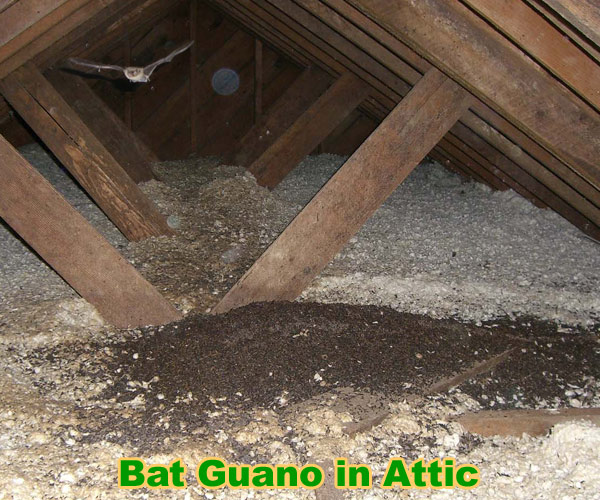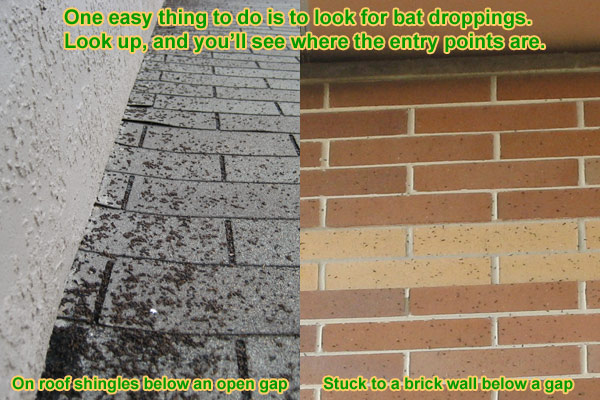It looks like dark brown grains of rice.
Fairly uniform in size. Sometimes the ends are a bit pointy or
it's a bit irregular, but for the most part, the ends are
rounded and it's consistent in shape. Yeah, I really can't think
of a better description than dark brown grains of rice,
sometimes clumped together a bit, due to urine.
Bat droppings have a VERY distinct odor, but until the internet acquires smell-o-vision (TM) in the year 2026, I can't describe it to you here. It smells a bit like my mother-in-law's cooking. I kid, I kid.
Click here to read my complete guide to how to clean up bat waste in an attic.
A picture is worth a thousand words, so here you go, some photographs of bat shit:

Here you can see a pile in the attic. If you have a pile like this, it's from bats. Rats and squirrels and mice scatter theirs about the attic, usually on the tunnels or runways in your insulation, and they will never be in high enough quantity to form a pile like this. This is actually not a huge pile of bat crap. I've seen guano cover the entire attic space up to two feet deep! The ceilings in that house eventually sagged and collapsed, by the way.

Here's a close-up photo of bat feces near an entry hole at the edge of a dormer soffit. Most of the droppings are inside the soffit and attic of course, since that's where the bats roost, but many of them tumble out and onto the roof and then onto the ground. As you can see, they look like brown grains of rice.

A common scenario is droppings falling out of an entry gap and onto a roof below. Again, the vast bulk of the bat turds are inside the building, but some spill out and onto the roof shingles. On the right, you can see another common occurrence with bat poop: the pellets stick to the wall of a building near the entry hole, as the bats poo in the air while they fly around in circles near the entry, waiting for their chance to land.
Are there any problems associated with bat dung? Yes. First off, there's the smell. Second, there's the corrosive properties, which can degrade your home's wood or drywall. Third, the droppings tend to attract a lot of cockroaches and other bugs. Fourth, mold can grow on the guano, which can serve as fertile ground for the funcus that causes the lung disease histoplasmosis in humans. Read more about histoplasmosis from bats.
HELP: If you need professional help in solving your bat problem, please click on my Hiring Advice and 2018 Directory of Bat Removal Professionals serving every city in the USA.
Go back to my main bats in the attic home page.
Bat droppings leaking through the wall - Bat droppings are one of the main reasons why people should consider excluding these animals from the home. Bat waste can have a horrible smell and will promote the growth of mold and fungus that is dangerous to people. Aside from their droppings and the risk of rabies, bats do very little damage to a home. They are not like rats, mice, and squirrels that need to chew on things to keep teeth filed down. The bat simply wants a dark place to escape the weather and predators. It has no interest in chewing on your building. If you’ve noticed bat droppings leaking through your wall, the first thing you need to do is install a one way door to exclude the bats. Once the animals are gone you can focus on the cleaning that needs to happen. Cleaning up from a bat colony does not mean just scooping poop into a bag. You need to find a way to replace or thoroughly clean the porous materials that have been affected. Leaving the staining will just mean the smell will persist and dangerous microscopic organisms can grow. There is no reason not to clean up the bat waste. If you need help, a professional wildlife removal company will be able to advise you.
What about bat urine? It's not possible to shovel out or vacuum up. But you can clean it, with a product called Bioshield, or Bac-a-Zap, or any of a number of similar special cleansers. BioShield is an enzymatic cleaner used by professionals to help eliminate the urine and fecal markings left behind after a bat infestation. BioShield is safe and non-toxic, and is applied through the use of a commercial-grade applicator. This product is used in conjunction with good safety gear. You should never attempt to clean up rodent waste without a protective suit, goggles, mask, and gloves. This might sound like overkill, but an attic that has been under siege by rats will have potent odors and dangerous bacteria. Many people don’t realize it, but rats can transmit over thirty diseases, and most of those don’t even have to be through direct contact. If you’re looking to decontaminate your home after a rodent issue, you should consider leaving clean up to the pros. Trying to clean up a large space after multiple rodents will be a daunting task, and one that might result in a hospital visit if you aren’t properly attired. Even vacuuming or sweeping droppings is enough to thrust dangerous particles into the air. Once they enter your lungs, you have a serious chance of developing a fatal illness. Let the experts come in and use their BioShield spray. It will be well worth your expenditure.
Read more articles about bats:
Bat urine removal and urine stain removal
Is bat feces dangerous to touch or breathe?
How to remove bat feces from concrete
Signs and evidence you have bats in attic
Bat droppings have a VERY distinct odor, but until the internet acquires smell-o-vision (TM) in the year 2026, I can't describe it to you here. It smells a bit like my mother-in-law's cooking. I kid, I kid.
Click here to read my complete guide to how to clean up bat waste in an attic.
A picture is worth a thousand words, so here you go, some photographs of bat shit:

Here you can see a pile in the attic. If you have a pile like this, it's from bats. Rats and squirrels and mice scatter theirs about the attic, usually on the tunnels or runways in your insulation, and they will never be in high enough quantity to form a pile like this. This is actually not a huge pile of bat crap. I've seen guano cover the entire attic space up to two feet deep! The ceilings in that house eventually sagged and collapsed, by the way.

Here's a close-up photo of bat feces near an entry hole at the edge of a dormer soffit. Most of the droppings are inside the soffit and attic of course, since that's where the bats roost, but many of them tumble out and onto the roof and then onto the ground. As you can see, they look like brown grains of rice.

A common scenario is droppings falling out of an entry gap and onto a roof below. Again, the vast bulk of the bat turds are inside the building, but some spill out and onto the roof shingles. On the right, you can see another common occurrence with bat poop: the pellets stick to the wall of a building near the entry hole, as the bats poo in the air while they fly around in circles near the entry, waiting for their chance to land.
Are there any problems associated with bat dung? Yes. First off, there's the smell. Second, there's the corrosive properties, which can degrade your home's wood or drywall. Third, the droppings tend to attract a lot of cockroaches and other bugs. Fourth, mold can grow on the guano, which can serve as fertile ground for the funcus that causes the lung disease histoplasmosis in humans. Read more about histoplasmosis from bats.
HELP: If you need professional help in solving your bat problem, please click on my Hiring Advice and 2018 Directory of Bat Removal Professionals serving every city in the USA.
Go back to my main bats in the attic home page.
Bat droppings leaking through the wall - Bat droppings are one of the main reasons why people should consider excluding these animals from the home. Bat waste can have a horrible smell and will promote the growth of mold and fungus that is dangerous to people. Aside from their droppings and the risk of rabies, bats do very little damage to a home. They are not like rats, mice, and squirrels that need to chew on things to keep teeth filed down. The bat simply wants a dark place to escape the weather and predators. It has no interest in chewing on your building. If you’ve noticed bat droppings leaking through your wall, the first thing you need to do is install a one way door to exclude the bats. Once the animals are gone you can focus on the cleaning that needs to happen. Cleaning up from a bat colony does not mean just scooping poop into a bag. You need to find a way to replace or thoroughly clean the porous materials that have been affected. Leaving the staining will just mean the smell will persist and dangerous microscopic organisms can grow. There is no reason not to clean up the bat waste. If you need help, a professional wildlife removal company will be able to advise you.
What about bat urine? It's not possible to shovel out or vacuum up. But you can clean it, with a product called Bioshield, or Bac-a-Zap, or any of a number of similar special cleansers. BioShield is an enzymatic cleaner used by professionals to help eliminate the urine and fecal markings left behind after a bat infestation. BioShield is safe and non-toxic, and is applied through the use of a commercial-grade applicator. This product is used in conjunction with good safety gear. You should never attempt to clean up rodent waste without a protective suit, goggles, mask, and gloves. This might sound like overkill, but an attic that has been under siege by rats will have potent odors and dangerous bacteria. Many people don’t realize it, but rats can transmit over thirty diseases, and most of those don’t even have to be through direct contact. If you’re looking to decontaminate your home after a rodent issue, you should consider leaving clean up to the pros. Trying to clean up a large space after multiple rodents will be a daunting task, and one that might result in a hospital visit if you aren’t properly attired. Even vacuuming or sweeping droppings is enough to thrust dangerous particles into the air. Once they enter your lungs, you have a serious chance of developing a fatal illness. Let the experts come in and use their BioShield spray. It will be well worth your expenditure.
Read more articles about bats:
Bat urine removal and urine stain removal
Is bat feces dangerous to touch or breathe?
How to remove bat feces from concrete
Signs and evidence you have bats in attic